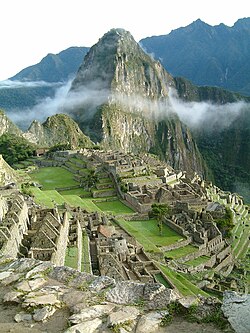
Back Перу Abkhazian Pèru ACE Перу ADY Peru Afrikaans Peru ALS ፔሩ Amharic Peru AMI Perú AN Peru ANG पेरु ANP
Republic of Peru | |
|---|---|
| Motto: "Firme y feliz por la unión" (Spanish) "Firm and Happy for the Union" | |
| Anthem: "Himno Nacional del Perú" (Spanish) "National Anthem of Peru"
| |
| National seal Gran Sello del Estado (Spanish) Great Seal of the State | |
 | |
| Capital and largest city | Lima 12°2.6′S 77°1.7′W / 12.0433°S 77.0283°W |
| Official language | Spanish |
| Co-official languages[a] | |
| Ethnic groups | List of ethnic groups |
| Religion | List of religions
|
| Demonym(s) | Peruvian |
| Government | Unitary presidential republic[1][2] |
| Pedro Castillo | |
| Dina Boluarte | |
| Aníbal Torres | |
| Legislature | Congress of the Republic[4] |
| Independence from the Kingdom of Spain | |
• Declared | July 28, 1821 |
| December 9, 1824 | |
• Recognized | August 14, 1879 |
| Area | |
• Total | 1,285,216 km2 (496,225 sq mi) (19th) |
• Water (%) | 0.41 |
| Population | |
• 2020 estimate | |
• 2017 census | 31,237,385 |
• Density | 23/km2 (59.6/sq mi) (198th) |
| GDP (PPP) | 2020 estimate |
• Total | |
• Per capita | |
| GDP (nominal) | 2020 estimate |
• Total | |
• Per capita | |
| Gini (2017) | medium |
| HDI (2018) | high · 82th |
| Currency | Sol (PEN) |
| Time zone | UTC−5 (PET) |
| Date format | dd.mm.yyyy (CE) |
| Driving side | right |
| Calling code | +51 |
| ISO 3166 code | PE |
| Internet TLD | .pe |


Peru is a country in South America. The capital is Lima. The ruins of Machu Picchu, the Andes mountains, and the source of the Amazon River are all found in Peru.
Peru is bordered to the north by Ecuador and Colombia, to the east by Brazil, to the south by Chile, and to the southeast by Bolivia. Peru is a representative democratic republic divided into 25 regions and over 33 million people live in it.
Peruvian territory was home to the Norte Chico civilization, one of the oldest in the world, and to the Inca Empire, the largest state in Pre-Columbian America. The Spanish Empire conquered the region in the 16th century and established a Viceroyalty, which included most of its South American colonies. After achieving independence in 1821.
Peru suffered a terrible guerrilla war in the 1980s. The communist (Maoist) Shining Path tried to take over the country. But after the leader of the group was captured in 1992, Shining Path was not a threat anymore. During the 1990s, it was ruled by President Alberto Fujimori. During this time, the economy of Peru got better, and it became easier to start a company or operate a business. After Fujimori, Alejandro Toledo was elected President, and then Alan Garcia, who was President from 1985 to 1990, was elected again in 2006. Ollanta Humala was elected President in 2011 and Pedro Pablo Kuczynski was elected President in 2016. In March 2018, Kuczynski resigned following political scandals and Vice President Martín Vizcarra was sworn-in as the next president.
Cite error: There are <ref group=lower-alpha> tags or {{efn}} templates on this page, but the references will not show without a {{reflist|group=lower-alpha}} template or {{notelist}} template (see the help page).
- ↑ Shugart, Matthew Søberg (September 2005). "Semi-Presidential Systems: Dual Executive and Mixed Authority Patterns" (PDF). Graduate School of International Relations and Pacific Studies. Archived from the original (PDF) on August 19, 2008. Retrieved August 31, 2017.
{{cite journal}}: Invalid|ref=harv(help) - ↑ Shugart, Matthew Søberg (December 2005). "Semi-Presidential Systems: Dual Executive And Mixed Authority Patterns". French Politics. 3 (3): 323–351. doi:10.1057/palgrave.fp.8200087. ISSN 1476-3427. OCLC 6895745903.
Only in Latin America have all new democracies retained a pure presidential form, except for Peru (president-parliamentary) and Bolivia (assembly-independent).
{{cite journal}}: Invalid|ref=harv(help) - ↑ Kurmanaev, Anatoly; Andrea Zarate, Andrea (September 30, 2019). "Peru's President Dissolves Congress, and Lawmakers Suspend Him". The New York Times. Retrieved October 2, 2019.
- ↑ Constitutionally dissolved until a new election in January 26, 2020.[3]
- ↑ "Perú: Estimaciones y Proyecciones de Población Total, por Años Calendario y Edades Simples, 1950–2050" [Peru: Estimates and Projections of Total Population, by Calendar Years and Simple Ages, 1950-2050] (PDF) (in Spanish). National Institute of Statistics and Informatics. September 2009.
- ↑ 6.0 6.1 6.2 6.3 "Peru". International Monetary Fund.
- ↑ "Gini Index". World Bank. Retrieved April 6, 2019.
- ↑ "2019 Human Development Report" (PDF). United Nations Development Programme. 2019. Retrieved December 9, 2019.


